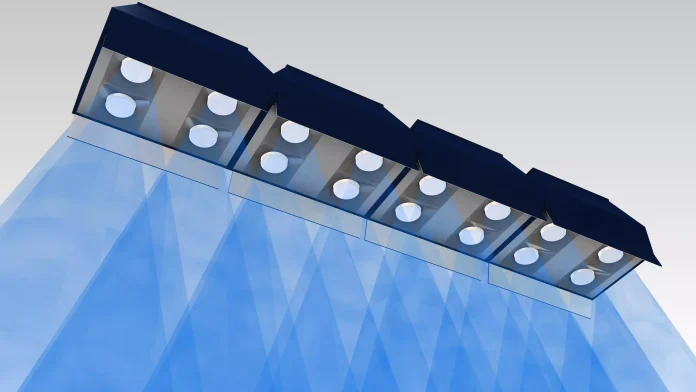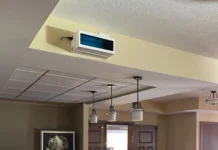By Liz Stevens, writer, UV Solutions
Deep Light Photonics, Inc., headquartered in Los Angeles, California, and founded by CEO Michael D. Tiberi, has developed and begun manufacture of a novel, high-power polychromatic, pulsed light source that is mercury-free. The eUV® uses an electron beam in an evacuated glass envelope to excite proprietary phosphors, producing UV-C emission with peaks at 232 nm, 242 nm, 261 nm and 272 nm. The primary application opportunities seen for the product include germicidal, sanitation and disinfection use.
How would you characterize the eUV?
This technology is a very interesting mix of an old school technology (i.e., cathode ray tubes) and a new school kind of technology (the unique phosphors). The luminescent material that produces the UV-C germicidal light is a proprietary mixture. We have finetuned the composition of the phosphors to deliver very high efficiency when it is stimulated by electrons.
The eUV product includes a high-voltage power supply, a circuit board and a UV-C lamp. One product option currently is available: the eUV-7p (12 keV, 7.0 mA peak cathode current), and the eUV-20p (12 keV, 20.0 mA peak cathode current) is in the works. Both products feature instant-on, 100 us pulse width, 1.25 kHz pulse frequency and cover an emission area of roughly 20 cm2. The lamps can be combined into arrays for even greater area coverage and optical power output. Biological testing from a distance of 10 cm in a 60 second exposure demonstrated a 4.1 log reduction of E. coli and a 2.4 log reduction of MRSA.
What are some advantages of this technology’s design?
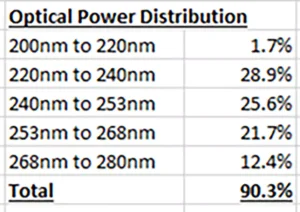 The vacuum tubes themselves are very compact and are a well-known commodity. There was a time when they were made in the millions of units, so economies of scale are intrinsic to the technology. Another upside is that they can be produced inexpensively. These are simple devices – just a glass envelope with a phosphor and conductive coating.
The vacuum tubes themselves are very compact and are a well-known commodity. There was a time when they were made in the millions of units, so economies of scale are intrinsic to the technology. Another upside is that they can be produced inexpensively. These are simple devices – just a glass envelope with a phosphor and conductive coating.
Is the polychromatic nature of the photon emission tunable to each specified wavelength, or does the eUV emit these wavelengths simultaneously?
It is simultaneous. The product uses an electron beam in a vacuum tube to excite proprietary phosphors resulting in UV-C polychromatic photon emission with four peaks, at 232, 242, 261 and 272 nanometers, and with the optical power distributed among the wavelength ranges. It emits all of these wavelengths at the same time.
What is the benefit of polychromatic photon emission?
With multiple wavelengths, there are multiple ways to inactivate pathogens. One can affect a microorganism’s DNA, its RNA or its protein structure with different UV-C wavelengths and deactivate it. Every microorganism has a different vulnerability to the wavelengths in the UV-C spectrum – its particular action spectrum. The eUV® is unique as a polychromatic light source; there is only one other mercury-free polychromatic light source available – the xenon lamp, but these are expensive and operate at almost 1,000° C.
Your product can operate in refrigerated environments. Why is that important?
Refrigeration is common in the food sector, which is a promising market for the eUV. Food refrigeration systems sometimes use UV-C lamps to disinfect the air circulating in that environment. It is possible to circulate the air flow and subject the air space to UV-C light to kill the airborne pathogens in a cooled or in an uncooled environment. Mercury lamps cannot be used in a refrigerated environment; the mercury will precipitate out of the gas phase, rendering it incapable of emitting UV-C light. The eUV, therefore, is a unique option for disinfecting air with UV-C in a refrigerated environment.
What other markets can benefit from this technology?
We see market opportunities in surface, air and water applications. In the surface arena, the product could be used in UV curing, food processing, cannabis growing facilities and surface cleaning. Air flow applications include odor control and food preservation. There are many potential applications for water, including pools and spas, aquaculture, life sciences, wastewater, drinking water and water reclamation. These can be addressed with no risk of leaking toxic materials into the environment – clean and green.
Can you expand on an opportunity in the food preservation market?
I am currently working with Tatiana Koutchma, Ph.D., AgriFood Canada, who is evaluating our eUV technology for its efficacy in applying UV-C light to micro-toxins in grain harvests during post-harvest processing. Corn, wheat and other grains are susceptible to fungal material that destroys the crop. There are ways to destroy the fungal material chemically but that can leave residual chemicals that could adversely affect human and animal consumers. AgriFood Canada is looking into how to use UV-C light as a germicide, including testing our technology to inactivate microorganisms of concern and extend the shelf-life of the food.
(Professor Koutchma and Victor Vincentz, CEO, Concept Light, Groupe Vincentz, France – Department UV LED, recently authored a featured article, “UV LED Solutions to Prevent Pathogen Transmission in Food Service,” which appeared in UV Solutions, 2021, Issue 3.)
You mentioned cannabis-growing facilities as a potential market. Would that be the same kind of application of your product as for food preservation – to irradiate cannabis with UV-C to reduce mycotoxin contamination?
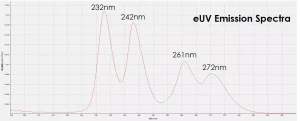 Yes, absolutely. The post-harvest situation for cannabis is similar to grain post-harvest, where grains are being moved and treated on a conveyor belt system. In the cannabis world, a lot of the crop is lost due to fungus and mold, so extending its life makes sense for people who are spending their time and effort to grow the product. There are not a lot of good solutions out there for dealing with cannabis. Some cannabis growers use a powerful and dangerous x-ray device to kill Aspergillus, a pathogen common to cannabis. Our aim is to provide a better, green solution for that.
Yes, absolutely. The post-harvest situation for cannabis is similar to grain post-harvest, where grains are being moved and treated on a conveyor belt system. In the cannabis world, a lot of the crop is lost due to fungus and mold, so extending its life makes sense for people who are spending their time and effort to grow the product. There are not a lot of good solutions out there for dealing with cannabis. Some cannabis growers use a powerful and dangerous x-ray device to kill Aspergillus, a pathogen common to cannabis. Our aim is to provide a better, green solution for that.
Bear in mind that it is not possible to eradicate all fungus or molds in cannabis or grains, but it can be reduced sufficiently to extend the shelf life. That’s really the objective, whether it be cannabis, strawberries or grains.
Can you expand a bit on why your product is a solid choice for use on consumables?
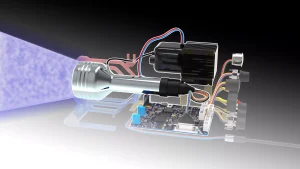 We took the best quality of a xenon lamp – its ability to produce short pulses of high energy – and put it into a better product. Using short pulses of high energy delivers greater inactivation efficacy. It is important to not hit consumables too hard with energy, which is where using short pulses comes into play. If you have a strawberry, for example, moving on a conveyor belt and you hit it with UV-C light, you want to make sure it still will taste like a strawberry when it comes out of the process. It is crucial to find the balance between microbial inactivation and maintaining the quality of the food.
We took the best quality of a xenon lamp – its ability to produce short pulses of high energy – and put it into a better product. Using short pulses of high energy delivers greater inactivation efficacy. It is important to not hit consumables too hard with energy, which is where using short pulses comes into play. If you have a strawberry, for example, moving on a conveyor belt and you hit it with UV-C light, you want to make sure it still will taste like a strawberry when it comes out of the process. It is crucial to find the balance between microbial inactivation and maintaining the quality of the food.
What is the life span of your product, and the requirements for its end-of-life disposal or recycling?
The lifetime of the product is about 20,000 hours. There is nothing toxic in the product; it is a non-toxic, mercury-free light source. This is a completely green technology, but we are very keen on cradle-to-grave technologies so when we go into production in any kind of volume, we will take responsibility for proper recycling and disposal and possible reuse of the device.
Tiberi has 20+ years of experience in semiconductor laser and high-tech fields. Deep Light Photonics has established international business relationships in Japan, China, Germany and Russia, and has a US manufacturer in place for onshore production of the lamps. For more information, email info@deeplightphotonics.com.


